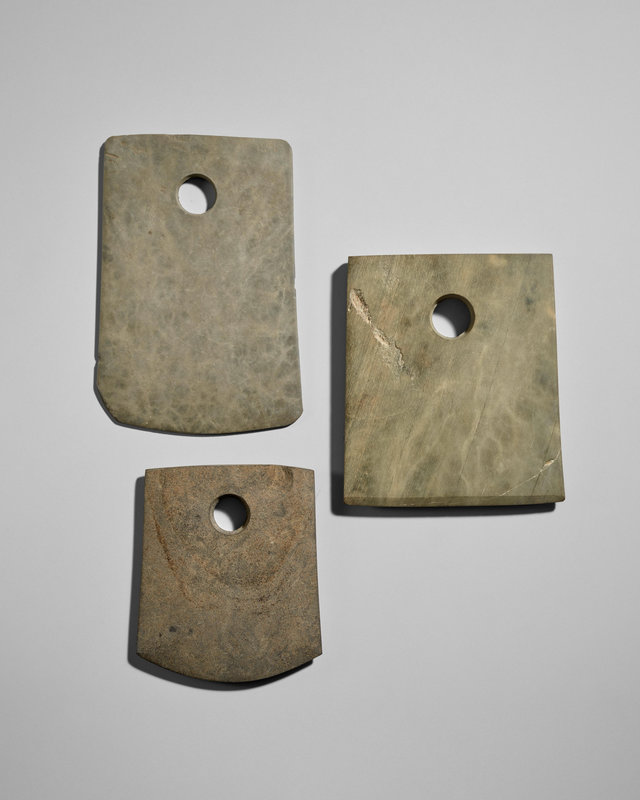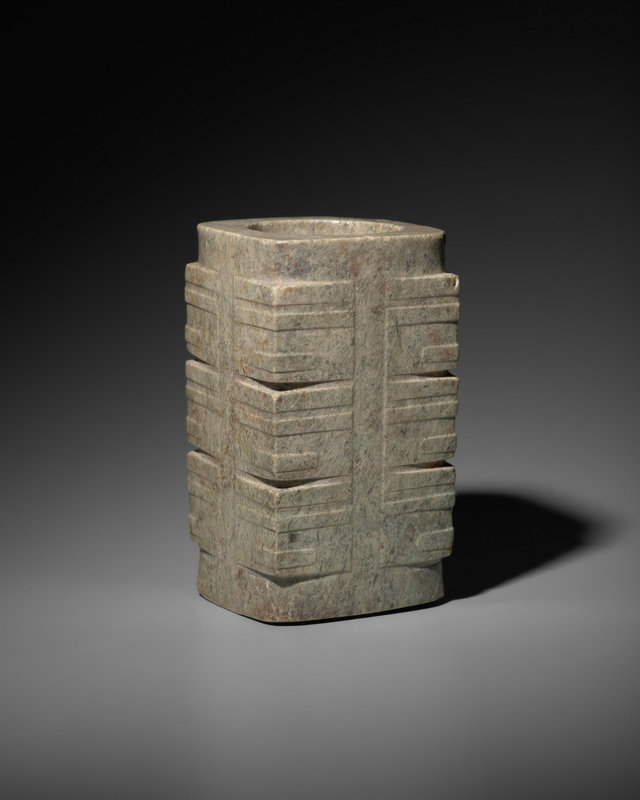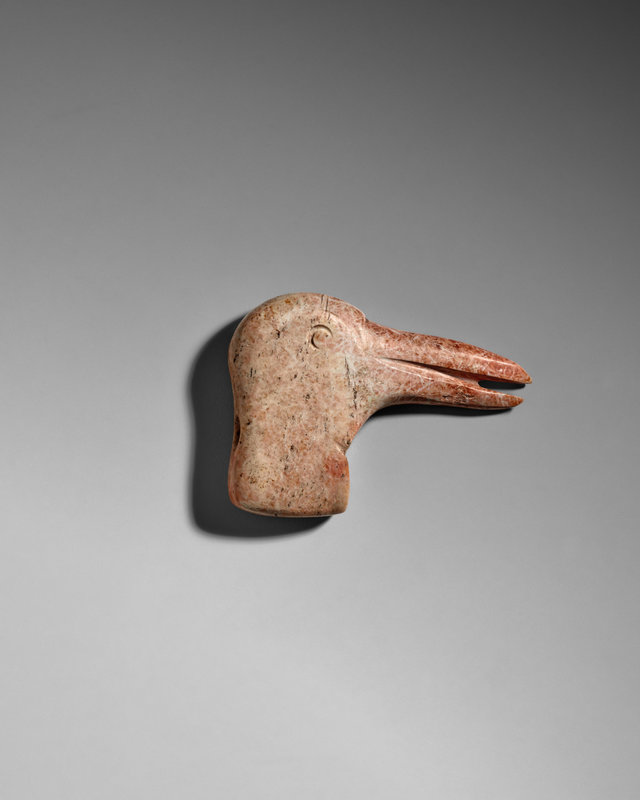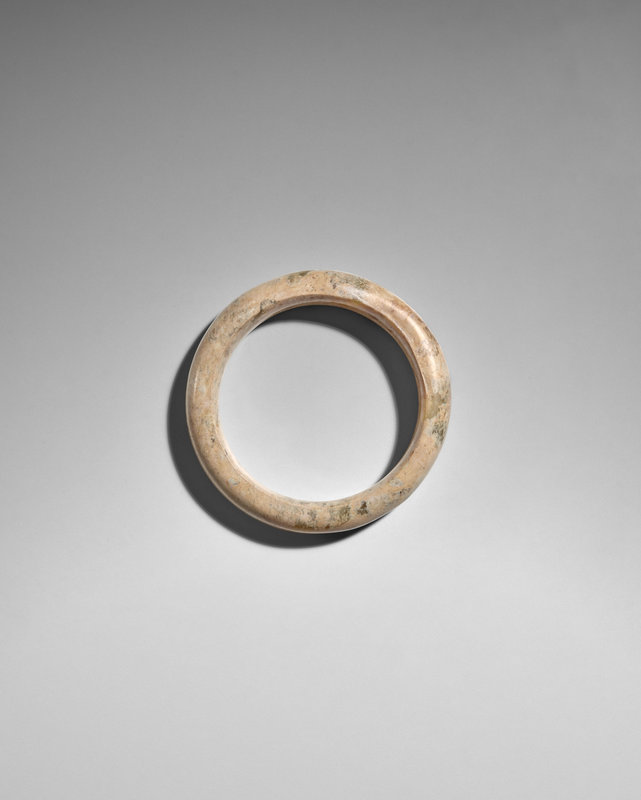Neolithic Stone & Jade sold at Bonhams New York, 20 March 2023
Lot 12. Three Neolithic mottled dark gray stone axes, fu, circa 5th-3rd millennium B.C.; 4 1/2, 5 1/8 and 6 1/8in (11.5, 13 and 15.5cm) lengths (3). Sold for US$3,570 (Estimate US$1,000-US$1,500). © Bonhams 2001-2023
Note: Stone axes with finely polished surface were made for ceremonial purposes. Following the forms of farming tools and weapons, they represent power in agriculture and in war. Although made of stone rather than jade, the choice of the material, the precision of the cut, and the degree of polish to reveal the beauty of the stone all attest high achievement of craftsmanship in the pre-historic time.
Stone axes of this form with beveled cutting edge have been excavated from Neolithic sites all over China, including most famously from the Dawenkou culture (circa 4300-2400 B.C.) in Shandong province, the Xuejiagang site (circa 3000 B.C.) in Anhui province, and the Shixia site (circa 2500 B.C.) in Guangdong province. Compare, for example, stone axes of closely related forms illustrated by Rawson, Chinese Jade from the Neolithic to the Qing, London, 1995, pp. 172-175, with a thorough discussion of ceremonial blades on pp. 167-169.
Lot 13. A Neolithic brown stone hand axe, ben, Late Neolithic period; 4 1/4in (10.8cm) length; 2 3/16in (5.6cm) width. Sold for US$6,120 (Estimate US$600-US$800). © Bonhams 2001-2023
Of flattened oblong shape and bulging convex on the wide sides, the cutting edge bevelled on both sides and the butt end left blunt, the stone of deep purplish maroon color polished smooth.
Note: Compare a stone axe of this type discovered at Zhangying, Changping district, a suburb of Beijing, illustrated in Changping Zhangying--Excavation Report on the Early Bronze Age Site at the Southern Foot of Yanshan Mountain, Beijing, 2007, pl. 19-6, with description and line drawings on p. 83, 77-4.
Lot 14. A Neolithic mottled gray-green jade cong, Liangzhu Culture, circa 3000-2500 B.C.; 4 1/4in (10.7cm) high. Sold for US$94,875 (Estimate US$8,000 - 12,000). © Bonhams 2001-2023
The slightly tapered square tube with a thick collar on each end, section into four tiers of matching panels angled over the four corners, each corner finely carved and engraved with a stylized 'mask,' separated by a plain vertical band on each side, the interior drilled in cylindrical form, the stone of moss green color mottled in dark grey throughout.
Note: Compare the Liangzhu jade cong with five tiers of corner-panels of stylized 'masks,' excavated from tomb no. 1 at the Shedunmiao site, Haining, Zhejiang province and now in the collection of the Haining Museum, illustrated by Gu (ed.) in Zhongguo chutu yuqi quanji (Complete Collection of Jades Unearthed in China), Vol. 8, Zhejiang, Beijing, 2005, p. 32.
Compare also the Liangzhu jade cong carved with five tiers of stylized 'masks,' unearthed at Meijiali, Zhejiang province, illustrated in the catalogue of the special exhibition at the Arthur M. Sackler Museum of Art and Archaeology at Beijing University by Qin and Fang (eds.), Quanli yu xinyang: Liangzhu yizhi qun kaogu tezhan (Power in Things: New Perspectives on Liangzhu), Beijing, 2015, pp. 211-213, no. II-2-1, with description on p. 385.
Lot 15. A jade notched disk, Late Neolithic period - early Shang dynasty; 5 7/8in (15cm) diam. Sold for US$48,255 (Estimate US$7,000 - 9,000). © Bonhams 2001-2023
A wide aperture at the center, notched on the outer edge three evenly spaced wedges swirling toward the same direction, each wedge with three shallow square tabs on the ridge and a indent at the tip, the inner rim slightly larger on one side and finished with a shallow groove, the flat sides with lines of cutting tracks polished smooth, the stone evenly 'calcified' to cream color with few earth encrustations still remain.
Note: Qing dynasty connoisseur Wu Dacheng (1835-1902) identified in his publication Guyu tukao the notched jade disc as Xuanji (璿璣) (vol. 2, p. 50a), a mythic, poetic name first recorded in Shang shu (Book of Documents) as xuanji yuheng (璿璣玉衡), a reference interpreted by Han dynasty scholars as an astrological device used in ancient rituals. However, in 20th century archaeological excavations the notched jade discs were often placed together with circular jade discs (bi) on the chest of the deceased in the burial context, therefore the term yabi (toothed disc) was assigned to correctly address function.
A smaller jade yabi, with pairs of blunt notched teeth carved on each of the three arcs, excavated from a Longshan Culture (circa 3000-1700 B.C.) site at Tengxian, Shandong province, is illustrated by Xia, Kaogu xuebao, 1984, No. 4, pl. 2:1, with a stone example from a late Shang burial at Anyang, Henan province, loc. cit., pl. 1. The same jade yabi is illustrated in color in Zhongguo yuqi quanji (Compendium of Chinese Jades), Vol. 1, Primitive Society, Shijiazhuang, 1992, p. 34, col. pl. 42.
Another similar jade yabi in the collection of the Palace Museum, Beijing is illustrated in Gugong bowuyuan cang wenwu zhenpin quanji (The Complete Collection of Treasures of the Palace Museum), Jadeware (I), Hong Kong, 1995, p. 58, no. 49; and another similar yabi in the collection of the Kaifeng Museum is illustrated by Gu (ed.), Zhongguo chuanshi yuqi quanji (Chinese Jades in Traditional Collections), Vol. 1, Neolithic Period, Shang, Western Zhou, Spring and Autumn Period, Warring States Period, Beijing, 2010, p. 84.
Compare also the yabi of similar form in the Arthur M. Sackler Gallery, Washington D.C., illustrated in Asian Art in the Arthur M. Sackler Gallery, The Inaugural Gift, Washington, D.C., 1987, p. 89, no. 45; another illustrated by Loehr, Ancient Chinese Jades from the Grenville L. Winthrop Collection in the Fogg Art Museum, Harvard University, Cambridge, 1975, p. 103, no. 106; and another closely related jade yabi in the British Museum, illustrated by Rawson, Chinese Jade from the Neolithic to the Qing, London, 1995, p. 163, pl. 8:1.
For a comprehensive discussion of yabi discs excavated in China, see Luan, "Yabi yanjiu (Researches on Yabi)," Wenwu, 2005, No. 7, pp. 69-81.
Lot 16. A Neolithic jade 'cloud' openwork pendant, Hongshan culture, circa 3500-2500 B.C.; 5 3/8in (13.6cm) length. Sold for US$40,695 (Estimate US$8,000 - 12,000). © Bonhams 2001-2023
The flat plaque with a circular aperture off-center below a half-crescent shape opening, flanked by a pair of slits with narrow borders at either side separating the 'C'-shaped hooks above and below, drilled with a small hole on the short flat border for suspension, the gently undulating surface with wide shallow grooves following the design, the edges subtly honed all around, the light-green stone with streaks of dark green markings and showing mottled cream-color on one side.
Note: An openwork jade pendant with two circular apertures and crescent slits paired at the center, excavated at the large Hongshan temple and stone mound burial complex at Niuheliang in Liaoning province, is illustrated in Wenwu, 2008, No. 10, p. 26, col. pl. 26 and in a line drawing on p. 28, pl. 32, no. 3.
Compare also the fragment of a Hongshan jade pendant in the National Museum of History, Taipei, illustrated by Johnson and Chan in the catalogue of the special exhibition organized by the San Antonio Museum of Art, 5,000 Years of Chinese Jade, San Antonio, 2011, p. 36, no. 1.
Lot 17. A Neolithic jade bird-head vorm finial, Hongshan culture, circa 3500-2500 B.C.;3 1/4in (8.3cm) length; 2 1/4in (5.7cm) high. Sold for US$38,175 (Estimate US$8,000 - 12,000). © Bonhams 2001-2023
Carved as the profile of a seagull-like bird, the eyes in the shape of the crescent and its long beak slightly open, the stone mottled orange-brown softly polished.
Note: Compare the closely related finial attributed to the late Hongshan culture, in the collection of the National Palace Museum, Taipei, illustrated by Teng (ed.), Jingtian gewu: Zhonggup lidai yuqi daodu, Taipei, 2011, p. 57, nos. 4-5-10a and 4-5-10b, described as the finial for a staff.
Lot 17. Two Neolithic grey stone axes, fu, circa 5th-3rd millenium B.C.; 8 and 7 1/8in (20.2 and 18.2cm) lengths (2). Sold for US$2,805 (Estimate US$800 - 1,200). © Bonhams 2001-2023
Lot 18. Two Neolithic striated grey stone axes, fu, circa 5th-3rd millenium B.C.; 8 and 7 1/8in (20.2 and 18.2cm) lengths (2). Sold for US$2,550 (Estimate US$600 - 800). © Bonhams 2001-2023
Lot 19. A Neolithic jade bracelet, zhuo, Liangzhu culture, circa 3000-2500 B.C.; 3 1/8in (7.9cm) diam. Sold for US$57,075 (Estimate US$1,500 - 2,500). © Bonhams 2001-2023
With thick half-round sides and gently convex inner wall, the stone polished smooth with cream and pale brown mottling throughout.
Note: Compare the similar jade bracelets with half-round sides illustrated in Liangzhu wenhua yuqi (Liangzhu Culture Jades), Hong Kong, 1989, pp. 72 and 73, nos. 96 and 97.
Lot 20. A large Neolithic mottled grey jade cong, Liangzhu culture, circa 3000-2500 B.C.; 5/8in (37.2cm) high. Sold for US$1,500,375 (Estimate US$30,000 - 50,000). © Bonhams 2001-2023
The tall tapering square tube with thick collars on each end, sectioned into thirteen tiers of matching panels angled over the four corners, each corner finely engraved with a stylized 'mask,' separated by a plain vertical band on each side, hollowed by drilling from both ends, leaving rough edge at the interior near the middle where the drills met, the stone of dark olive-green tones with opaque alterations from burial.
Note: Compare the very large jade cong from the Sidun site illustrated and discussed by Sun in "Chinese Jades", R. Scott (ed.), Colloquies on Art & Archaeology in Asia, No. 18, Percival David Foundation of Chinese Art, London, 1997, p.58, pl.19, where the author notes that the Sidun site has been dated to the late Liangzhu period, after 2400 B.C. Another tall Liangzhu jade cong in the collection of Shanghai Museum is illustrated in the exhibition catalog, Gems of Liangzhu Culture, Hong Kong, 1992, pp. 158-159, no. 56.
Compare also two other Neolithic jade cong from the Collection of Sir Joseph Hotung, illustrated by J. Rawson in Chinese Jade from the Neolithic to the Qing, London, 1995, pp. 128-9, nos. 3:5 and 3:6, where the author notes that comparable jade cong are in the British Museum and the Victoria and Albert Museum in London, and in major collections in the United States, including the Sonnenschein Collection at the Art Institute of Chicago, the Winthrop Collection in the Harvard University Art Museums and in the Freer Gallery of Art, Washington, D.C.
Bonhams. J. J. Lally & Co. Fine Chinese Works of Art, New York, March 20, 2023

/https%3A%2F%2Fprofilepics.canalblog.com%2Fprofilepics%2F1%2F0%2F100183.jpg)
/https%3A%2F%2Fstorage.canalblog.com%2F03%2F02%2F119589%2F96711876_o.jpg)
/https%3A%2F%2Fstorage.canalblog.com%2F11%2F31%2F119589%2F94773502_o.jpg)
/https%3A%2F%2Fstorage.canalblog.com%2F20%2F83%2F119589%2F94772815_o.jpg)
/https%3A%2F%2Fstorage.canalblog.com%2F26%2F72%2F119589%2F75604929_o.jpg)
/https%3A%2F%2Fstorage.canalblog.com%2F59%2F60%2F119589%2F26458628_o.jpg)

































/http%3A%2F%2Fstorage.canalblog.com%2F43%2F28%2F119589%2F129853364_o.jpg)
/http%3A%2F%2Fstorage.canalblog.com%2F50%2F04%2F119589%2F129632031_o.jpg)
/http%3A%2F%2Fstorage.canalblog.com%2F54%2F95%2F119589%2F129597348_o.jpg)
/http%3A%2F%2Fstorage.canalblog.com%2F13%2F95%2F119589%2F128404810_o.jpg)